Janet Fox's Blog, page 38
July 4, 2011
The Heart of Great Stories: Tension
Tension. It lies at the heart of every great story. As writers, we should strive with every scene and every chapter to increase the tension in our stories, to build the tension moment by moment so that our readers are never tempted to set our book down and head out to the nearest pizza party.
This is increasingly true in modern fiction. Back in the day, when Herman Melville could compose page after page of detailed narrative having to do with the inner workings of a cetacean ear (and readers would put up with it), tension developed slowly in a work of fiction. Melville's most exciting moments in Moby Dick came in the closing chapters of the novel, and by then readers were either asleep or determined or insane enough to finish.
 Today, readers – especially you teens and tweens – wouldn't put up with that kind of pacing for a minute. Frankly, neither would I. [True confession: I gave up on
Moby
a bit more than halfway through, and rented the movie to discover the rest. Don't tell your English teacher.]
Today, readers – especially you teens and tweens – wouldn't put up with that kind of pacing for a minute. Frankly, neither would I. [True confession: I gave up on
Moby
a bit more than halfway through, and rented the movie to discover the rest. Don't tell your English teacher.]
We want and expect a high degree of tension in our stories, so the question is, how do we writers handle it?
I'll answer this over the course of a few posts, but here is one thing I talked about briefly in my plotting workshop at New England SCBWI this past spring: tension means having to make your protagonist suffer.
You and I are good people. We don't want to hurt anybody. If you are, like I am, a mom (and I imagine even if you are not), that goes double: every child on the planet is your child and you will protect him or her even if it means throwing yourself in front of a moving train. Your characters are your children. So it stands to reason – you're going to shield your character from every hurt, bump, scrape, bruise, terror. Right?
Not if you are a novelist in search of tension. You must be willing to watch your protagonist suffer every imaginable kind of horror. Look at The Hunger Games . Katniss all but dies, again and again, and every one of her near-death experiences heightens the tension of the books. Suzanne Collins does not protect Katniss from life experiences. As a result we readers are sucked into the story, rooting for Katniss – and Katniss learns every step of the way how to better protect herself and those she loves.
Tension in the form of character suffering, then, sucks readers into your story, but it serves a double purpose: it allows for character growth and change. Which is another aspect of great story-telling.

This is increasingly true in modern fiction. Back in the day, when Herman Melville could compose page after page of detailed narrative having to do with the inner workings of a cetacean ear (and readers would put up with it), tension developed slowly in a work of fiction. Melville's most exciting moments in Moby Dick came in the closing chapters of the novel, and by then readers were either asleep or determined or insane enough to finish.
 Today, readers – especially you teens and tweens – wouldn't put up with that kind of pacing for a minute. Frankly, neither would I. [True confession: I gave up on
Moby
a bit more than halfway through, and rented the movie to discover the rest. Don't tell your English teacher.]
Today, readers – especially you teens and tweens – wouldn't put up with that kind of pacing for a minute. Frankly, neither would I. [True confession: I gave up on
Moby
a bit more than halfway through, and rented the movie to discover the rest. Don't tell your English teacher.]We want and expect a high degree of tension in our stories, so the question is, how do we writers handle it?
I'll answer this over the course of a few posts, but here is one thing I talked about briefly in my plotting workshop at New England SCBWI this past spring: tension means having to make your protagonist suffer.
You and I are good people. We don't want to hurt anybody. If you are, like I am, a mom (and I imagine even if you are not), that goes double: every child on the planet is your child and you will protect him or her even if it means throwing yourself in front of a moving train. Your characters are your children. So it stands to reason – you're going to shield your character from every hurt, bump, scrape, bruise, terror. Right?
Not if you are a novelist in search of tension. You must be willing to watch your protagonist suffer every imaginable kind of horror. Look at The Hunger Games . Katniss all but dies, again and again, and every one of her near-death experiences heightens the tension of the books. Suzanne Collins does not protect Katniss from life experiences. As a result we readers are sucked into the story, rooting for Katniss – and Katniss learns every step of the way how to better protect herself and those she loves.
Tension in the form of character suffering, then, sucks readers into your story, but it serves a double purpose: it allows for character growth and change. Which is another aspect of great story-telling.
Published on July 04, 2011 20:22
June 26, 2011
A Million Thanks
Launching a book is like some combination of giving birth, running a marathon, and taking final exams...except that (in theory) none of the above lasts three or more weeks (and if you've ever had a final exam last that long, please spill. I'll send you a box of chocolates.) I am so grateful to the many people who supported me during the last month with the launch of FORGIVEN. Here are a few folks I wish to acknowledge.
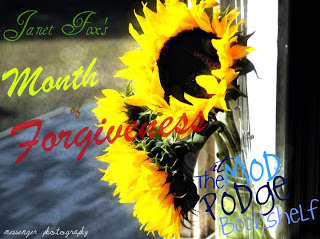 First and foremost, Gabrielle Carolina ran a "Month of Forgiveness" on her gorgeous blog, Mod Podge Bookshelf. This act of kindness came directly from her heart, and gave a place for me to launch my campaign on behalf of exploited children (see end of post for ways to help), a campaign that grew out of a subplot in FORGIVEN.
First and foremost, Gabrielle Carolina ran a "Month of Forgiveness" on her gorgeous blog, Mod Podge Bookshelf. This act of kindness came directly from her heart, and gave a place for me to launch my campaign on behalf of exploited children (see end of post for ways to help), a campaign that grew out of a subplot in FORGIVEN.
Then a passel of lovely bloggers hosted me with interviews and guest posts - thank you for your interest, support and very kind words and reviews! They are:
Rebecca's Book Blog
YA Bliss
First Page Panda
The Fourth Musketeer
Mundie Moms
 The Book Butterfly
The Book Butterfly
Poisoned Rationality
A Good Addiction
Confessions of a Bookaholic
My Friend Amy
Lauren's Crammed Bookshelf
Books Complete Me
Lost For Words
Compulsive Reader
YA Addict
I also want to thank fellow writers Joy Preble and PJ Hoover, who both hosted giveaways on their blogs.
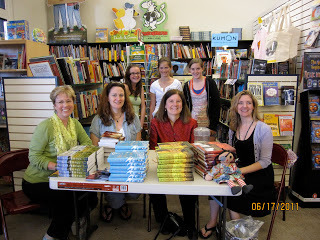 And booksellers! The Country Bookshelf in Bozeman hosted my launch party (above.) I had wonderful book discussions and signings at Tinman Too in Spokane, and at Yellow Book Road in San Diego (at left.)
And booksellers! The Country Bookshelf in Bozeman hosted my launch party (above.) I had wonderful book discussions and signings at Tinman Too in Spokane, and at Yellow Book Road in San Diego (at left.)
And many, many thanks to Barbara Fisch and Sarah Shealy of Blue Slip Media, and Katie Kurtzman at Penguin.
My main character in FORGIVEN, Kula Baker, uncovers a sad fact of life in San Francisco at the turn of the last century: the slavery and exploitation of mostly Chinese children. I was deeply saddened by this fact, but more deeply disturbed that this type of exploitation still exists. As a result I will donate a portion of the proceeds from FORGIVEN to The National Center for Missing & Exploited Children. To learn more about what you can do to help agencies that actively fight the exploitation and trafficking of children, visit the following websites:
The National Center for Missing & Exploited Children
Unicef
Stop Child Trafficking
 First and foremost, Gabrielle Carolina ran a "Month of Forgiveness" on her gorgeous blog, Mod Podge Bookshelf. This act of kindness came directly from her heart, and gave a place for me to launch my campaign on behalf of exploited children (see end of post for ways to help), a campaign that grew out of a subplot in FORGIVEN.
First and foremost, Gabrielle Carolina ran a "Month of Forgiveness" on her gorgeous blog, Mod Podge Bookshelf. This act of kindness came directly from her heart, and gave a place for me to launch my campaign on behalf of exploited children (see end of post for ways to help), a campaign that grew out of a subplot in FORGIVEN.Then a passel of lovely bloggers hosted me with interviews and guest posts - thank you for your interest, support and very kind words and reviews! They are:
Rebecca's Book Blog
YA Bliss
First Page Panda
The Fourth Musketeer
Mundie Moms
 The Book Butterfly
The Book ButterflyPoisoned Rationality
A Good Addiction
Confessions of a Bookaholic
My Friend Amy
Lauren's Crammed Bookshelf
Books Complete Me
Lost For Words
Compulsive Reader
YA Addict
I also want to thank fellow writers Joy Preble and PJ Hoover, who both hosted giveaways on their blogs.
 And booksellers! The Country Bookshelf in Bozeman hosted my launch party (above.) I had wonderful book discussions and signings at Tinman Too in Spokane, and at Yellow Book Road in San Diego (at left.)
And booksellers! The Country Bookshelf in Bozeman hosted my launch party (above.) I had wonderful book discussions and signings at Tinman Too in Spokane, and at Yellow Book Road in San Diego (at left.)And many, many thanks to Barbara Fisch and Sarah Shealy of Blue Slip Media, and Katie Kurtzman at Penguin.
My main character in FORGIVEN, Kula Baker, uncovers a sad fact of life in San Francisco at the turn of the last century: the slavery and exploitation of mostly Chinese children. I was deeply saddened by this fact, but more deeply disturbed that this type of exploitation still exists. As a result I will donate a portion of the proceeds from FORGIVEN to The National Center for Missing & Exploited Children. To learn more about what you can do to help agencies that actively fight the exploitation and trafficking of children, visit the following websites:
The National Center for Missing & Exploited Children
Unicef
Stop Child Trafficking
Published on June 26, 2011 11:27
June 12, 2011
PJ Hoover on SOLSTICE: An Alternate Route to Publishing
"P. J. Hoover first fell in love with Greek mythology in sixth grade thanks to the book Mythology by Edith Hamilton. After a fifteen year bout as an electrical engineer designing computer chips for a living, P. J. decided to take her own stab at mythology and started writing books for kids and teens. P. J. is also a member of
THE TEXAS SWEETHEARTS & SCOUNDRELS
. When not writing, P. J. spends time with her husband and two kids and enjoys practicing Kung Fu, solving Rubik's cubes, and watching Star Trek.Her first novel for teens, Solstice, takes place in a Global Warming future and explores the parallel world of mythology beside our own. Her middle grade fantasy novels, The Emerald Tablet, The Navel of the World, and The Necropolis, chronicle the adventures of a boy who discovers he's part of two feuding worlds hidden beneath the sea."
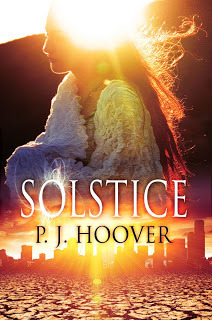 She doesn't know this, but as I read P.J.'s bio I realized we had several "likes" in common. Mythology and Star Trek are two of those, and until I moved away last year we were both Texans. Now I see P.J. when I go back to Texas occasionally, and I was intrigued to hear about her new project and debut YA, SOLSTICE. P.J. graciously agreed to explain both the novel and its unique inception.
She doesn't know this, but as I read P.J.'s bio I realized we had several "likes" in common. Mythology and Star Trek are two of those, and until I moved away last year we were both Texans. Now I see P.J. when I go back to Texas occasionally, and I was intrigued to hear about her new project and debut YA, SOLSTICE. P.J. graciously agreed to explain both the novel and its unique inception.
I just downloaded your new YA novel SOLSTICE, and am very excited to read. Before we talk about the publishing angle, please give readers a brief synopsis.
Hi Janet! Thanks for asking! SOLSTICE is set is a future where global warming is destroying the earth. Summer never ends, and governments are trying all sorts of crazy things to survive. Amid this mess, a girl named Piper opens a box on her birthday, and her world shifts. She finds out that, parallel to her global warming earth, there is a world of mythology, and somehow she's linked to it. So she meets gods, tries to save her best friend from death, and falls into a bizarre love triangle. And, of course, things become complicated beyond all possible reason, and Piper has to find a way to survive.
I know that you've taken an "alternate" route to publishing. How did arrive at this plan? What was the editorial process like?
My agent was the one to suggest the independent publishing route. We talked about the pros and cons, and after thinking on it, I decided to give it a go. My agent was very clear that she would support me whatever decision I made.As for the editorial process, the word that comes to mind is intense. I've revised SOLSTICE more times than I can count, but now I have a story I'm super proud to share with the world.
Your cover is gorgeous - did you have much input?
Thank you! I offered up thoughts on the cover but then didn't see it until it was complete. My agency picked the stock photo and sent it to a cover designer who did the work. I'm pretty sure no matter what input I might have had, the final result would have blown it away. There was never any thought of asking for any changes.
Do you think this route is less risky for you because you already have a reader following? Would you recommend it to beginning writers?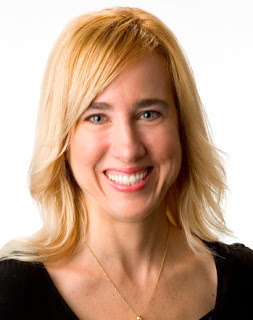
I absolutely adore SOLSTICE and am thrilled it is already in the hands of readers (as opposed to having to wait a year and a half). For SOLSTICE, it just felt like the right route. And for beginning writers, I think the world of publishing is changing, and anything can be placed on the table for consideration, whether there is a reader following or not. My biggest recommendation no matter what route is taken is to have your book edited.
What about schools and libraries? Do you have a marketing plan for those markets?
SOLSTICE should be coming out in print form at some point, and would then be available to schools and libraries in that form. Also, I think there are some programs in place for ebooks to be lent out at libraries, though each library varies in what is possible. I'm a huge believer in libraries, and as the publishing world shifts, libraries and the models they use will shift along with it.
What is your take on the "e-book/actual book" controversy (or do you think there is a controversy?)
Like e-book vs. print? I don't think there is a controversy per se. You have some readers who swear they just love the feel of a real book in their hands, and I used to be one. And then I tried a Nook, and seriously, I love it (as does the rest of my family). I kind of view paper books and LPs in a similar fashion. They are nostalgic and awesome, but buying and reading on an e-reader is so easy to do, just like listening to music on iTunes is simple.
Please give readers some way to find out more about you and your books. Thanks, Tricia!
Everything anyone would ever want to know is on my website (www.pjhoover.com), and if it's not, then there are lots of ways to contact me. I'm on twitter, facebook, and my email is also available. I love answering questions and interacting with readers, so please get in touch!

 She doesn't know this, but as I read P.J.'s bio I realized we had several "likes" in common. Mythology and Star Trek are two of those, and until I moved away last year we were both Texans. Now I see P.J. when I go back to Texas occasionally, and I was intrigued to hear about her new project and debut YA, SOLSTICE. P.J. graciously agreed to explain both the novel and its unique inception.
She doesn't know this, but as I read P.J.'s bio I realized we had several "likes" in common. Mythology and Star Trek are two of those, and until I moved away last year we were both Texans. Now I see P.J. when I go back to Texas occasionally, and I was intrigued to hear about her new project and debut YA, SOLSTICE. P.J. graciously agreed to explain both the novel and its unique inception.
I just downloaded your new YA novel SOLSTICE, and am very excited to read. Before we talk about the publishing angle, please give readers a brief synopsis.
Hi Janet! Thanks for asking! SOLSTICE is set is a future where global warming is destroying the earth. Summer never ends, and governments are trying all sorts of crazy things to survive. Amid this mess, a girl named Piper opens a box on her birthday, and her world shifts. She finds out that, parallel to her global warming earth, there is a world of mythology, and somehow she's linked to it. So she meets gods, tries to save her best friend from death, and falls into a bizarre love triangle. And, of course, things become complicated beyond all possible reason, and Piper has to find a way to survive.
I know that you've taken an "alternate" route to publishing. How did arrive at this plan? What was the editorial process like?
My agent was the one to suggest the independent publishing route. We talked about the pros and cons, and after thinking on it, I decided to give it a go. My agent was very clear that she would support me whatever decision I made.As for the editorial process, the word that comes to mind is intense. I've revised SOLSTICE more times than I can count, but now I have a story I'm super proud to share with the world.
Your cover is gorgeous - did you have much input?
Thank you! I offered up thoughts on the cover but then didn't see it until it was complete. My agency picked the stock photo and sent it to a cover designer who did the work. I'm pretty sure no matter what input I might have had, the final result would have blown it away. There was never any thought of asking for any changes.
Do you think this route is less risky for you because you already have a reader following? Would you recommend it to beginning writers?

I absolutely adore SOLSTICE and am thrilled it is already in the hands of readers (as opposed to having to wait a year and a half). For SOLSTICE, it just felt like the right route. And for beginning writers, I think the world of publishing is changing, and anything can be placed on the table for consideration, whether there is a reader following or not. My biggest recommendation no matter what route is taken is to have your book edited.
What about schools and libraries? Do you have a marketing plan for those markets?
SOLSTICE should be coming out in print form at some point, and would then be available to schools and libraries in that form. Also, I think there are some programs in place for ebooks to be lent out at libraries, though each library varies in what is possible. I'm a huge believer in libraries, and as the publishing world shifts, libraries and the models they use will shift along with it.
What is your take on the "e-book/actual book" controversy (or do you think there is a controversy?)
Like e-book vs. print? I don't think there is a controversy per se. You have some readers who swear they just love the feel of a real book in their hands, and I used to be one. And then I tried a Nook, and seriously, I love it (as does the rest of my family). I kind of view paper books and LPs in a similar fashion. They are nostalgic and awesome, but buying and reading on an e-reader is so easy to do, just like listening to music on iTunes is simple.
Please give readers some way to find out more about you and your books. Thanks, Tricia!
Everything anyone would ever want to know is on my website (www.pjhoover.com), and if it's not, then there are lots of ways to contact me. I'm on twitter, facebook, and my email is also available. I love answering questions and interacting with readers, so please get in touch!
Published on June 12, 2011 15:34
June 5, 2011
Why I Write for Teens, or, Life is an Often Overwhelming Challenge
In
Forgiven
, Kula arrives in San Francisco in 1906 prepared for challenges but not for this: the enslavement of children. I've written about this before, and will again. Young girls (average age, around 10 - young girls, let's be frank) were either kidnapped or sold into slavery in China and brought to California to service the men of San Francisco.
San Francisco of the time was more or less lawless, with a government happy to take bribes in order to look the other way, and an underground culture extant in both the Barbary Coast and in Chinatown. The city was filled with men fresh from the gold mines or the railroads or the seas, and they were looking for entertainment of the most basic kind. That's what these children (let's be truly frank) provided. Most died before maturity. Many died in childbirth or because they were pregnant and were deliberately starved to death.
Let's be truly, truly frank. This was the most abhorrent kind of child sexual abuse imaginable - the girls were caged (yes, you read that right) in cribs no larger than a dog kennel.
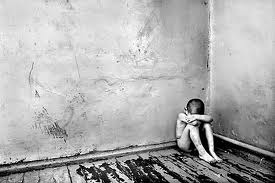 Now, why would I write about such depravity - for young adults, no less?
Now, why would I write about such depravity - for young adults, no less?
Because it existed. And it still exists today: as many as 1.2 million (yes, you read that right, again) children are subjected to this kind of trafficking and abuse worldwide - and don't even get me started on the issue of child brides, which is a disgusting form of legal child abuse.
If I seem particularly impassioned it is because of a recent article in the Wall Street Journal, in which the author despairs that YA fiction today features depravity. Really? Well. My reasonably "clean" novel features the kind of depravity imposed only by adults on children.
Should young adults not be exposed to this reality?
Let's not even address here issues of teaching tolerance and awareness. Let's go directly to the heart of it: what teens feel like.
Recently I wrote a blog post for Dear Teen Me about how I felt as a teen. I had a relatively sheltered and happy childhood - no abuse, drugs, or dislocations. Yet I suffered from depression, isolation and bullying. It took a huge toll on me, but I survived. Readers of my post celebrated my bravery for speaking about it.
But I think teens today are the brave ones. They face a world of challenges and painful realities. They face a world of changing climate, of financial instability, of political upheaval. They face profound choices and dilemmas that make what we faced in the past decades seem tame.
They face childhood slavery and exploitation.
And that doesn't begin to address their personal feelings - about being different, outsider, odd, peculiar, shunned, bullied, ignored...you name it, kids feel it. And they need to know they are not alone. They need to know they can rise above. They need to know they can get help.
For pity's sake, they need to know they can help.
YA literature today saves. It saves because it faces those issues head on. It saves because if provides an outlet, or an inspiration, or an example.
YA saves. Yes, it does.
Here's an organization that helps kids suffering from exploitation:
National Center for Missing and Exploited Children
San Francisco of the time was more or less lawless, with a government happy to take bribes in order to look the other way, and an underground culture extant in both the Barbary Coast and in Chinatown. The city was filled with men fresh from the gold mines or the railroads or the seas, and they were looking for entertainment of the most basic kind. That's what these children (let's be truly frank) provided. Most died before maturity. Many died in childbirth or because they were pregnant and were deliberately starved to death.
Let's be truly, truly frank. This was the most abhorrent kind of child sexual abuse imaginable - the girls were caged (yes, you read that right) in cribs no larger than a dog kennel.
 Now, why would I write about such depravity - for young adults, no less?
Now, why would I write about such depravity - for young adults, no less?Because it existed. And it still exists today: as many as 1.2 million (yes, you read that right, again) children are subjected to this kind of trafficking and abuse worldwide - and don't even get me started on the issue of child brides, which is a disgusting form of legal child abuse.
If I seem particularly impassioned it is because of a recent article in the Wall Street Journal, in which the author despairs that YA fiction today features depravity. Really? Well. My reasonably "clean" novel features the kind of depravity imposed only by adults on children.
Should young adults not be exposed to this reality?
Let's not even address here issues of teaching tolerance and awareness. Let's go directly to the heart of it: what teens feel like.
Recently I wrote a blog post for Dear Teen Me about how I felt as a teen. I had a relatively sheltered and happy childhood - no abuse, drugs, or dislocations. Yet I suffered from depression, isolation and bullying. It took a huge toll on me, but I survived. Readers of my post celebrated my bravery for speaking about it.
But I think teens today are the brave ones. They face a world of challenges and painful realities. They face a world of changing climate, of financial instability, of political upheaval. They face profound choices and dilemmas that make what we faced in the past decades seem tame.
They face childhood slavery and exploitation.
And that doesn't begin to address their personal feelings - about being different, outsider, odd, peculiar, shunned, bullied, ignored...you name it, kids feel it. And they need to know they are not alone. They need to know they can rise above. They need to know they can get help.
For pity's sake, they need to know they can help.
YA literature today saves. It saves because it faces those issues head on. It saves because if provides an outlet, or an inspiration, or an example.
YA saves. Yes, it does.
Here's an organization that helps kids suffering from exploitation:
National Center for Missing and Exploited Children
Published on June 05, 2011 19:52
June 2, 2011
Release, Or How Authors Cope With Emotional Ups and Downs
Today is "release day" for my second YA novel,
FORGIVEN
. I've known it was coming for almost a year; I turned in my last batch of edits over six months ago. Since it's been out of my hands for a while I've had plenty of time to stew, fret, get excited, get crazy, and generally experience all the other emotions that accompany the birth of a book.
Would it surprise you to learn that yesterday I thought I'd be sick? That I was so nauseated I couldn't eat (think of it as the "writer's diet"). That I haven't slept well in days. That I'm too strung out to work on the novel I should be working on. That I can't open my email or check Twitter without a pang of fear.
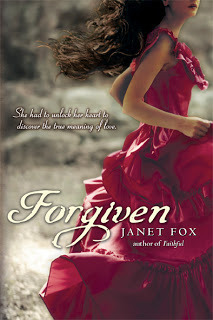 Some readers will love my work. Some readers will hate it. Most will fall somewhere in the middle. In this age of instant communication, impassioned points of view can be expressed to followers in a heartbeat, and this is what authors everywhere must cope with - the emotional high of having a reader love, love, love your book versus the devastating news that a reader has consigned it to the trash heap of literary history. I've read reviews of my work that make me weep with joy, and, well, I've done the other kind of weeping, too.
Some readers will love my work. Some readers will hate it. Most will fall somewhere in the middle. In this age of instant communication, impassioned points of view can be expressed to followers in a heartbeat, and this is what authors everywhere must cope with - the emotional high of having a reader love, love, love your book versus the devastating news that a reader has consigned it to the trash heap of literary history. I've read reviews of my work that make me weep with joy, and, well, I've done the other kind of weeping, too.
What matters most, however, what should matter most is how I feel about my work. Did I make the best possible effort to express what was in my heart? Did I give it every bit of my time and attention and say what I wanted to say? Is my character true? Is my story real? Is it the best I can do with the skills I have at my command right now?
I've heard apocryphal stories about authors who edit their work long after it's been published (yup, I do.) I know that expressing true and deep emotion is all I can aim for, and sometimes, sure, I miss the target. Most of the time as I write I struggle to say what I really mean. As I edit I try to carve through to the emotional heart. Each novel I write may (or, oh fear of fears, may not) take me closer to the bull's eye, but I must keep trying.
What all this adds up to is that I do have to let go of my novel. Release it. Okay, maybe I'll secretly take a red pen to my own dogeared copy, but in truth it's time for me to go on to the next novel. It's time to hush the evil genie of self-doubt and move on. It's time to try to find the heart of that new story, to try, try, try again to craft a story that rings true and fine.
"The thing that is really hard, and really amazing, is giving up on being perfect and beginning the work of becoming yourself." Anna Quindlen

Would it surprise you to learn that yesterday I thought I'd be sick? That I was so nauseated I couldn't eat (think of it as the "writer's diet"). That I haven't slept well in days. That I'm too strung out to work on the novel I should be working on. That I can't open my email or check Twitter without a pang of fear.
 Some readers will love my work. Some readers will hate it. Most will fall somewhere in the middle. In this age of instant communication, impassioned points of view can be expressed to followers in a heartbeat, and this is what authors everywhere must cope with - the emotional high of having a reader love, love, love your book versus the devastating news that a reader has consigned it to the trash heap of literary history. I've read reviews of my work that make me weep with joy, and, well, I've done the other kind of weeping, too.
Some readers will love my work. Some readers will hate it. Most will fall somewhere in the middle. In this age of instant communication, impassioned points of view can be expressed to followers in a heartbeat, and this is what authors everywhere must cope with - the emotional high of having a reader love, love, love your book versus the devastating news that a reader has consigned it to the trash heap of literary history. I've read reviews of my work that make me weep with joy, and, well, I've done the other kind of weeping, too.What matters most, however, what should matter most is how I feel about my work. Did I make the best possible effort to express what was in my heart? Did I give it every bit of my time and attention and say what I wanted to say? Is my character true? Is my story real? Is it the best I can do with the skills I have at my command right now?
I've heard apocryphal stories about authors who edit their work long after it's been published (yup, I do.) I know that expressing true and deep emotion is all I can aim for, and sometimes, sure, I miss the target. Most of the time as I write I struggle to say what I really mean. As I edit I try to carve through to the emotional heart. Each novel I write may (or, oh fear of fears, may not) take me closer to the bull's eye, but I must keep trying.
What all this adds up to is that I do have to let go of my novel. Release it. Okay, maybe I'll secretly take a red pen to my own dogeared copy, but in truth it's time for me to go on to the next novel. It's time to hush the evil genie of self-doubt and move on. It's time to try to find the heart of that new story, to try, try, try again to craft a story that rings true and fine.
"The thing that is really hard, and really amazing, is giving up on being perfect and beginning the work of becoming yourself." Anna Quindlen
Published on June 02, 2011 10:54
May 24, 2011
Craft Issue: Gray Space
 Recently I gave a couple of presentations at New England SCBWI. One was a discussion of plot, and the other a discussion of the topic of my master's thesis for Vermont College of Fine Arts, the concept of elision. Over the next few blog posts, I'm going to recap some of the ideas I presented.
Recently I gave a couple of presentations at New England SCBWI. One was a discussion of plot, and the other a discussion of the topic of my master's thesis for Vermont College of Fine Arts, the concept of elision. Over the next few blog posts, I'm going to recap some of the ideas I presented.Let's start with elision – and if you're scratching your head, that's just what I did when I heard the term for the first time at Vermont. Elision refers to the gaps in writing, to what is not said, to what is left out. I made it the subject of my thesis so that I could get a grasp of what it means and how to use it.
My exploration of the term took me to books like Proust and the Squid, in which author Maryanne Wolf makes a thorough exploration of the relationship between readers and writers and what happens within the reader's brain during reading. From that study I coined the term "gray space," by which I meant that place where readers and writers meet that is outside the words on the page. I like to think of it as the writer's equivalent to the artist's concept of "white space," and my own definition of gray space is the shadowy landscape of dreams where writers and readers meet.
Gray space can be created, can be manipulated by writers. It's something we may not consciously do during first drafting, but certainly can be added/enhanced during revision. Creating gray space is important to increasing tension in writing (adding a layer of mystery and nuance) and is critical in evoking a reader's emotional response.
In traditional text, gray space is formed by how we use the following rhetorical devices: repetition, word choice, and sentence structure. Dialogue techniques employing gray space include dropped sentences, beats, reversals, and interruptions. In subtext, gray space is created through the use of metaphor, slant telling, and gesture. And writers craft gray space "between the lines" as revealed by the choice of theme, or as Thomas McCormick in The Fiction Editor, the Novel, and the Novelist calls it, the novel's "master-effect."
This topic is the subject of an article currently available in the online journal Hunger Mountain , and there I explore it in much greater detail, in case you are curious.
Next time – a bit about plot.
Published on May 24, 2011 15:18
May 17, 2011
Debut Authors of the Class of 2k11: Amy Fellner Dominy
What a treat for readers. The Class of 2k11 has churned out so many fabulous books this year - and here's another. Today I'm featuring an interview with Amy Fellner Dominy about her debut novel OyMG .Congratulations, Amy, on the publication of your novel, OyMG . Can you tell us a bit about the story and what inspired it?
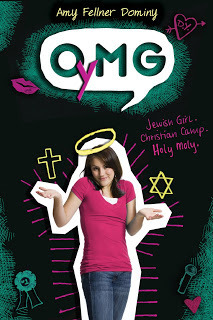 OyMG is about fourteen-year-old Ellie Taylor who goes to a summer speech and performing arts camp determined to win a private scholarship—and discovers she'll have to hide that she's Jewish if she wants to win.You know how people always say, "Write what you know?" Well, I always take that to mean, "Write about the feelings you know." And growing up as one of the only Jewish kids in my community and school, I knew how it felt to be different. I was proud of my faith, but at times (especially Christmas!) it was just plain hard. I wanted to be like everyone else.The question is how far will we go to conform and fit in? What part of ourselves are we willing to hide? From that question, Ellie Taylor and OyMG came to life.I love the premise! How long have you been writing for children/teens? Have you written other books or is this your first effort?If I could have held a pencil in the crib, I'd have been scrawling notes on the wooden bars. I submitted my first short story at the ripe old age of thirteen. It was rejected by American Girl magazine—I still have the form letter. I took a break to have a steady job (and paycheck) but even then I found a job where I could write; I was an advertising copywriter. I got serious about writing for kids again in 2004. In 2006, I started OyMG.Can you describe your path to the publication of OyMG?It began with a first page. Literally.
OyMG is about fourteen-year-old Ellie Taylor who goes to a summer speech and performing arts camp determined to win a private scholarship—and discovers she'll have to hide that she's Jewish if she wants to win.You know how people always say, "Write what you know?" Well, I always take that to mean, "Write about the feelings you know." And growing up as one of the only Jewish kids in my community and school, I knew how it felt to be different. I was proud of my faith, but at times (especially Christmas!) it was just plain hard. I wanted to be like everyone else.The question is how far will we go to conform and fit in? What part of ourselves are we willing to hide? From that question, Ellie Taylor and OyMG came to life.I love the premise! How long have you been writing for children/teens? Have you written other books or is this your first effort?If I could have held a pencil in the crib, I'd have been scrawling notes on the wooden bars. I submitted my first short story at the ripe old age of thirteen. It was rejected by American Girl magazine—I still have the form letter. I took a break to have a steady job (and paycheck) but even then I found a job where I could write; I was an advertising copywriter. I got serious about writing for kids again in 2004. In 2006, I started OyMG.Can you describe your path to the publication of OyMG?It began with a first page. Literally.
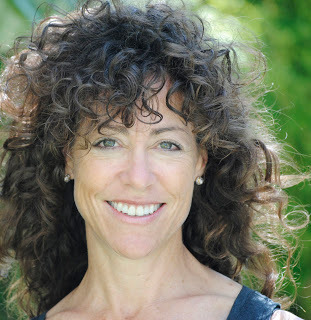 It was November 2006. My local SCBWI chapter was having a conference with agents and editors, and I wanted to submit something for the first page panel. (This is a program where the panel of editors and agents read out loud the first page of a book and then offer comments.)I submitted a first page and the audience loved it—including Caryn Wiseman, an agent with the Andrea Brown Literary Agency. Partly because of that first page, I signed with Caryn less than a month later.Unfortunately, writing the rest of the book was much trickier. I stopped and started it for over a year. Finally, in January of 2008, I figured out where I'd gone wrong. I deleted about 25,000 words and dove back in. And finally, I had a completed manuscript.With the same first page. :)The book finally went out to editors, summer 2008. I had interest from two editors who asked if I'd revise and resubmit. I did, but for various reasons, those situations didn't pan out. The book went out again, summer 2009. This time, it landed in the perfect hands: Stacy Cantor Abrams at Walker Books. I got an offer in August 2009. Nearly 3 years from the time I'd written the first page!What a great story - I love that you started with the first page only! Do you have any advice for beginning writers?Most "overnight successes" are many years in the making. Be patient with yourself and the process. The trick is to keep writing. Get a critique partner and set up monthly deadlines so you'll write new pages. Or sign up for a conference and commit to submitting pages. Anything to keep you moving forward. The more you write, the more you learn—about craft and voice and what stories you're meant to tell.Such perfect advice. Can you tell us something about your personal life – inspirations, plans for the future, goals, etc.?I love quotes. I always keep a couple of them stuck to my desk for inspiration. Right now, I have two favorites.#1 In a world where you can be anything, be yourself. I love this quote because it reminds me that the best, most special thing I can be is myself.#2 My inner voice hates me. This is my own quote and it's a reminder not to listen to self-doubts and negativity. I tend to worry and think the worst. This quote helps me to stay positive. Do you have any new writing ventures underway?I'm excited to announce the sale of a second novel to Walker Books!Audition and Subtraction is the story of fourteen-year old Tatum who faces competition in her school band from the new boy who just moved to town. Soon, she's at risk of losing her spot in District Honor Band—and maybe her best friend—in a story of shifting friendships, divided loyalties and unexpected romance. Audition and Subtraction will hit the shelves Fall 2012.Do you have a website where readers can learn more about OyMG? Yes! Please visit me at www.amyfellnerdominy.com. There's more info about myself and the book, including a reader's guide. You can also watch my book trailer on YouTube.Thanks for having me Janet!Thanks for coming, Amy!
It was November 2006. My local SCBWI chapter was having a conference with agents and editors, and I wanted to submit something for the first page panel. (This is a program where the panel of editors and agents read out loud the first page of a book and then offer comments.)I submitted a first page and the audience loved it—including Caryn Wiseman, an agent with the Andrea Brown Literary Agency. Partly because of that first page, I signed with Caryn less than a month later.Unfortunately, writing the rest of the book was much trickier. I stopped and started it for over a year. Finally, in January of 2008, I figured out where I'd gone wrong. I deleted about 25,000 words and dove back in. And finally, I had a completed manuscript.With the same first page. :)The book finally went out to editors, summer 2008. I had interest from two editors who asked if I'd revise and resubmit. I did, but for various reasons, those situations didn't pan out. The book went out again, summer 2009. This time, it landed in the perfect hands: Stacy Cantor Abrams at Walker Books. I got an offer in August 2009. Nearly 3 years from the time I'd written the first page!What a great story - I love that you started with the first page only! Do you have any advice for beginning writers?Most "overnight successes" are many years in the making. Be patient with yourself and the process. The trick is to keep writing. Get a critique partner and set up monthly deadlines so you'll write new pages. Or sign up for a conference and commit to submitting pages. Anything to keep you moving forward. The more you write, the more you learn—about craft and voice and what stories you're meant to tell.Such perfect advice. Can you tell us something about your personal life – inspirations, plans for the future, goals, etc.?I love quotes. I always keep a couple of them stuck to my desk for inspiration. Right now, I have two favorites.#1 In a world where you can be anything, be yourself. I love this quote because it reminds me that the best, most special thing I can be is myself.#2 My inner voice hates me. This is my own quote and it's a reminder not to listen to self-doubts and negativity. I tend to worry and think the worst. This quote helps me to stay positive. Do you have any new writing ventures underway?I'm excited to announce the sale of a second novel to Walker Books!Audition and Subtraction is the story of fourteen-year old Tatum who faces competition in her school band from the new boy who just moved to town. Soon, she's at risk of losing her spot in District Honor Band—and maybe her best friend—in a story of shifting friendships, divided loyalties and unexpected romance. Audition and Subtraction will hit the shelves Fall 2012.Do you have a website where readers can learn more about OyMG? Yes! Please visit me at www.amyfellnerdominy.com. There's more info about myself and the book, including a reader's guide. You can also watch my book trailer on YouTube.Thanks for having me Janet!Thanks for coming, Amy!
Published on May 17, 2011 12:51
May 15, 2011
Podcast from New England SCBWI and Katie Davis
Author
Katie Davis
has been producing podcasts for some time now. I didn't truly appreciate the value of a podcast until I met Katie at this weekend's
New England SCBWI
conference (which was amazing in every way). Katie invited me and
Tami Lewis Brown
to join her in her "studio" - an astonishing mobile recording area in her hotel room - for the following Q&A with Katie's listeners:
>
>
Published on May 15, 2011 18:08
May 10, 2011
Debut Authors of the Class of 2k11: Alissa Grosso
Today on the blog I'm delighted to introduce another of the awesome Class of 2k11, Alissa Grosso, whose debut YA is POPULAR , which sounds like a ton of fun and which sports another of the appealing covers that are hallmarks of this class.
 Congratulations on the publication of your novel, POPULAR. Can you tell us a bit about the story and what inspired it?
Congratulations on the publication of your novel, POPULAR. Can you tell us a bit about the story and what inspired it?Thank you. POPULAR tells the story of a high school clique with a dark secret that brings about their downfall. I'm not entirely sure what inspired it. I think there's a lot more to people than what we see onthe surface. I've also been drawn to quirky books and movies, and the classic high school movie HEATHERS is one of my favorites. So, somehow out of that idea that people aren't always who they seem and my love of quirky movies, POPULAR was born.
How long have you been writing for children/teens? Have you written other books or is this your first effort?
I never really consciously set out to write for teens. I just wanted to write a book that I would want to read. I do read a lot of YA and children's books, so I guess it only made sense that what I would write would be a YA book. This may not be my first effort, but it's definitely my first publishable effort.
Can you describe your path to the publication of POPULAR?
I wrote POPULAR over a series of several years, while working on other stuff as well. Then, I found myself with a finished manuscript, and didn't know what to do with it. On a whim, I sent it to a publisher, and lo and behold Flux wanted to publish my book. This sort of makes it sound like I had instant success as a writer, but I had been writing and submitting stuff for years, and had built up a verylarge collection of rejection letters. So, even though this particular manuscript didn't get a lot of rejections, I was already something of a writing veteran at this point.
Good for you for sticking with it! Do you have any other advice for beginning writers?
 Learn how to revise. Writing can be hard work, but writing is the easy part. Join a critique group or find some beta readers whose opinions you value.
Learn how to revise. Writing can be hard work, but writing is the easy part. Join a critique group or find some beta readers whose opinions you value.Can you tell us something about your personal life – inspirations, plans for the future, goals, etc.?
I think my goal has always been to spend more time doing what I want to do whether it is writing or just relaxing and enjoying life. I think every day I take another small step in this direction.
That is such a sane approach to life. Do you have any new writing ventures underway?
I always have a new writing venture underway. Right now, I am continuing to work on some young adult novels, no sequels, just new stuff.
Do you have a website where readers can learn more about POPULAR ?
My website is http://www.alissagrosso.com
Thanks, Alissa!
Published on May 10, 2011 16:21
May 8, 2011
What My Mom Gave Me
Security. Love. A passion for words. A passion for helping those who are helpless.
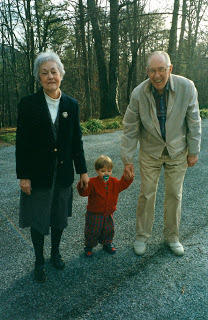 My mom was a soft-spoken and generous lady (yes, she really was) whose gentle exterior hid a tenacious and passionate Irish soul. Much of her passion was directed at helping others - her family first, and then those around her. If she were alive today, she'd be on the bandwagon for the cause I write about here. That is why this post isn't the usual hearts and flowers Mother's Day wish: instead it is my wish that all children could experience the kind of childhood I did, in the arms of loving parents, without pain or suffering of any kind.
My mom was a soft-spoken and generous lady (yes, she really was) whose gentle exterior hid a tenacious and passionate Irish soul. Much of her passion was directed at helping others - her family first, and then those around her. If she were alive today, she'd be on the bandwagon for the cause I write about here. That is why this post isn't the usual hearts and flowers Mother's Day wish: instead it is my wish that all children could experience the kind of childhood I did, in the arms of loving parents, without pain or suffering of any kind.
This picture of my mom and dad and son Kevin was taken a month before my mom died suddenly and unexpectedly.
This is a post I wrote for Mod Podge Bookshelf's Month of Forgiveness. For each comment to this post, I'll donate an additional dollar to The National Center for Missing and Exploited Children. Please help spread the word.
I want to warn you right now: this blog post contains information that is deeply disturbing. But please bear with me.
When I set out to write my second YA novel, FORGIVEN, I began my research knowing a little about San Francisco in the early 1900s. I'd heard about the Barbary Coast; and of course I knew Chinatown. But I didn't expect to uncover a dark world of child trafficking, and what I learned broke my heart.
From the mid-1800s on, girls as young as six were sold by their impoverished families in China to dealers who then transported them across the Pacific to San Francisco, a wild seaport and hub of the gold rush. Sometimes the girls were deluded into thinking they were bound for marriage, but those notions were dispelled once the children arrived and were sold to slave holders for as little as $100 (for a one-year-old girl) or as much as $2800 for a fourteen-year-old (this transaction took place in 1898). Most of the slaves were confined to "cribs" – tiny kennel-size enclosures just below street level – and then sold for 25 cents a visit. Few lived longer than six years; many were tortured; many were left to die of starvation if they were sick or pregnant.
We'll never know how many were buried or burned alive in the San Francisco earthquake. They had no voice.
As I write these words, my hands are shaking. They shake because I cannot imagine the horror that these girls must have experienced in their short and miserable lives. They shake because this kind of abuse still exists worldwide.

As many as 1.2 million children are trafficked every year. Mexican agencies report that more than 16,000 children work as prostitutes. In southeast Asia, 35% of prostitutes are children.
What can we do?
There are a number of agencies that actively fight the exploitation and trafficking of children. I urge you to check them out and become involved. Some seek volunteer help; some sponsor awareness campaigns; some need donations.
But please don't close your eyes.
Here are three agencies I recommend:
The National Center for Missing and Exploited Children
Unicef
Stop Child Trafficking
Thank you, Mom. I wish you were still here.

 My mom was a soft-spoken and generous lady (yes, she really was) whose gentle exterior hid a tenacious and passionate Irish soul. Much of her passion was directed at helping others - her family first, and then those around her. If she were alive today, she'd be on the bandwagon for the cause I write about here. That is why this post isn't the usual hearts and flowers Mother's Day wish: instead it is my wish that all children could experience the kind of childhood I did, in the arms of loving parents, without pain or suffering of any kind.
My mom was a soft-spoken and generous lady (yes, she really was) whose gentle exterior hid a tenacious and passionate Irish soul. Much of her passion was directed at helping others - her family first, and then those around her. If she were alive today, she'd be on the bandwagon for the cause I write about here. That is why this post isn't the usual hearts and flowers Mother's Day wish: instead it is my wish that all children could experience the kind of childhood I did, in the arms of loving parents, without pain or suffering of any kind.This picture of my mom and dad and son Kevin was taken a month before my mom died suddenly and unexpectedly.
This is a post I wrote for Mod Podge Bookshelf's Month of Forgiveness. For each comment to this post, I'll donate an additional dollar to The National Center for Missing and Exploited Children. Please help spread the word.
I want to warn you right now: this blog post contains information that is deeply disturbing. But please bear with me.
When I set out to write my second YA novel, FORGIVEN, I began my research knowing a little about San Francisco in the early 1900s. I'd heard about the Barbary Coast; and of course I knew Chinatown. But I didn't expect to uncover a dark world of child trafficking, and what I learned broke my heart.
From the mid-1800s on, girls as young as six were sold by their impoverished families in China to dealers who then transported them across the Pacific to San Francisco, a wild seaport and hub of the gold rush. Sometimes the girls were deluded into thinking they were bound for marriage, but those notions were dispelled once the children arrived and were sold to slave holders for as little as $100 (for a one-year-old girl) or as much as $2800 for a fourteen-year-old (this transaction took place in 1898). Most of the slaves were confined to "cribs" – tiny kennel-size enclosures just below street level – and then sold for 25 cents a visit. Few lived longer than six years; many were tortured; many were left to die of starvation if they were sick or pregnant.
We'll never know how many were buried or burned alive in the San Francisco earthquake. They had no voice.
As I write these words, my hands are shaking. They shake because I cannot imagine the horror that these girls must have experienced in their short and miserable lives. They shake because this kind of abuse still exists worldwide.

As many as 1.2 million children are trafficked every year. Mexican agencies report that more than 16,000 children work as prostitutes. In southeast Asia, 35% of prostitutes are children.
What can we do?
There are a number of agencies that actively fight the exploitation and trafficking of children. I urge you to check them out and become involved. Some seek volunteer help; some sponsor awareness campaigns; some need donations.
But please don't close your eyes.
Here are three agencies I recommend:
The National Center for Missing and Exploited Children
Unicef
Stop Child Trafficking
Thank you, Mom. I wish you were still here.
Published on May 08, 2011 09:22



